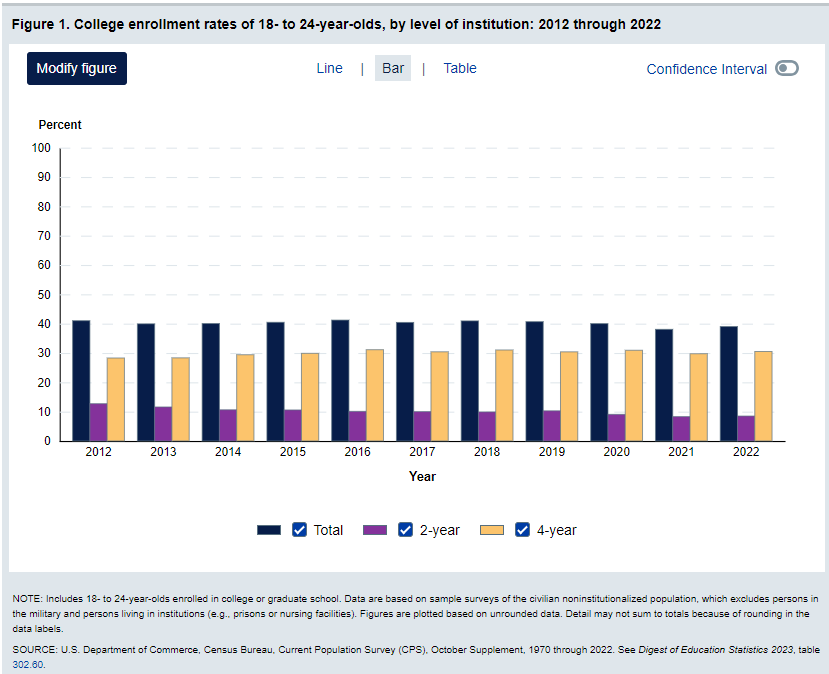Higher education trends have undergone some surprising changes over the past few years. And it’s not just in one specific area. Trends in higher education have changed in almost every aspect, from academic and technological to social and financial. Understanding these trends offers a deeper perspective on the future of higher education and what we can expect in the years to come.
A Look at the Current Trends in Higher Education
1. Online learning has become more commonplace
Online learning is one of the fastest-growing trends in higher education. An increasing number of students are choosing this non-traditional learning platform instead of enrolling in traditional universities. There are several reasons for this preference.
Students can enroll in any program they want without any restrictions of location, distance, or time. They don’t even have to be in the same city to enroll in an online program. The removal of geographical constraints makes this form of learning accessible to students from the remotest corner of the world.
Online programs also offer students the flexibility they would never get if they enrolled in a traditional university. With online classes, students can work, travel or attend to their other commitments while they study. One major advantage of online learning is that it costs only a fraction of what it costs to attend a traditional college. That means students can graduate with a recognized degree but without the overwhelming student loan debt.
2. Massive Open Online Courses (MOOCs) make education more accessible to everyone
Massive Open Online Courses (MOOCs) take online learning to the next level. These are open online courses that are designed to accommodate a larger number of participants. Students who enroll can access their programs anytime, from anywhere, for free. The unlimited enrollment, fewer qualifying requirements, and low-cost model make MOOCs more accessible to students around the world. It removes all geographical, time and financial restrictions, which has made it one of the more popular trends in higher education.
3. Educators are focusing on closing the skills gap
Technology has advanced in leaps and bounds over the past few years. Unfortunately, till very recently, education systems remained the same, completely disregarding ongoing technological advancements. This has had a huge impact on the workforce as many employees just don’t have the necessary skills for the job. As technology keeps advancing, there is an urgent need for education systems to stay updated to keep up with the evolving workplace. Educators are finally sitting up and taking notice of this growing skills gap and are working towards narrowing this gap. They are reimagining their curriculum with the aim of helping graduates be better prepared for workforce competitiveness.
4. The higher education student cohorts are getting more diverse
Higher education institutions are more diverse today than they have ever been. This higher education trend started sometime in the 1990s and has been growing in leaps and bounds since then. Today, educators are acknowledging the immense value of ethnic and racial diversity on campuses. They are striving to actively break down long-held barriers and achieve diversity. This is not only in the classrooms but also in their teaching faculty and administration.
Find top ethnically diverse colleges.
5. Higher number of non-traditional students in the classroom
This is one of the more interesting and unexpected trends in higher education. Traditionally, university and college students were typically eighteen to twenty-four year old’s. They applied to college immediately after graduating from high school, enrolled in full-time classes, and completed their degree in four years. Most were supported by their parents either wholly or partially. Today’s college landscape is vastly different.
Many individuals are returning to college to complete their degree after taking a break either to start a family or earn an income and become financially independent. They are much older than traditional students and are paying their own way through college. They are also juggling multiple personal and professional commitments while working towards their degree. The number of nontraditional students in the classroom is expected to keep increasing.
6. Increased awareness of the importance of mental health
Mental health was something nobody discussed on campuses until just a few years ago. The National Center for Education Statistics conducted several surveys and the results were alarming. Their studies indicated that a large number of students struggled with various types of mental illnesses with no one to turn to for help. Some of the mental health issues college students experienced ranged from anxiety, depression and addition to eating disorders and suicide.
Today, colleges and universities are working with mental health experts. Together they’ve to come up with various resources and approaches to help students struggling with mental health issues. This may be in the form of panel discussions, lectures by visiting mental health professionals, videos and even role-playing. These efforts have paid off big time as later studies show a huge improvement in students’ emotional well-being.
College Raptor’s free match tool can help you discover individualized college matches, personalized school price estimates, your acceptance odds, and potential financial aid at schools around the country!






